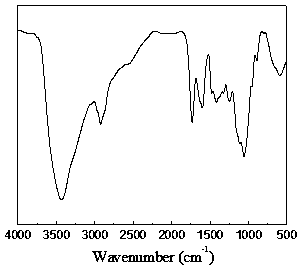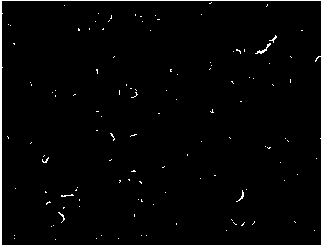Method for preparing carboxymethylcellulose sodium composite-filled polyamide nanofiltration membrane
A technology of sodium carboxymethyl cellulose and composites, which is applied in the field of preparation of polyamide nanofiltration membranes filled with sodium carboxymethyl cellulose composites, and can solve the problems of high manufacturing costs, inconspicuous modification effects, and easy aggregation of nanomaterials and other issues, to achieve the effect of convenient and easy access to raw materials, good industrial applicability, and improved transmission efficiency
- Summary
- Abstract
- Description
- Claims
- Application Information
AI Technical Summary
Problems solved by technology
Method used
Image
Examples
preparation example Construction
[0017] The preparation method of sodium carboxymethyl cellulose composite filled polyamide nanofiltration membrane comprises the steps:
[0018] (1) Dissolve 1-3 parts by mass of sodium carboxymethylcellulose and 0.5-2 parts by mass of cationic polyelectrolyte in 100-500 parts by mass of acidic aqueous solution, and then add the above-mentioned acidic aqueous solution of cationic polyelectrolyte to carry out ionic cross-linking in acidic aqueous solution of sodium carboxymethyl cellulose, precipitate with deionized water for many times, wash and dry to obtain sodium carboxymethyl cellulose complex; ~500 parts by mass of alkaline aqueous solution to form a composite dispersion;
[0019] (2) Dissolve the polyamine monomer in water, then add the compound dispersion and sodium hydroxide solid to make an aqueous phase solution; dissolve the polyacyl chloride monomer in an organic solvent to make an organic phase solution;
[0020] (3) Immerse the porous polysulfone support membran...
Embodiment 1
[0024]Get 1g sodium carboxymethyl cellulose and 0.5g polydimethyldiallyl ammonium chloride to be dissolved in 100g mass percentage concentration respectively in the hydrochloric acid aqueous solution of 0.01wt%, then above-mentioned polydimethyldiallyl chloride The ammonium chloride acidic aqueous solution was added dropwise to the sodium carboxymethylcellulose acidic aqueous solution to carry out ion cross-linking, after several times of deionized water precipitation, washing, and at 40 oC After drying for 16 hours at a lower temperature, the sodium carboxymethyl cellulose composite was obtained; then the above-mentioned 0.1g composite was added to 100g of a mass percentage concentration of 0.1wt% sodium hydroxide aqueous solution to form a composite dispersion; the porous poly The sulfone support membrane was immersed for 1 minute in the aqueous phase solution, the concentration of piperazine in the aqueous phase solution was 0.2 wt%, the concentration of the complex was 0.0...
Embodiment 2
[0027] Get 3 g sodium carboxymethyl cellulose and 2 g polydimethyldiallyl ammonium chloride to be dissolved in 500 g mass percent concentration respectively in the hydrochloric acid aqueous solution of 0.1 wt%, then above-mentioned polydimethyldiallyl Ammonium chloride acidic aqueous solution was added dropwise to carboxymethylcellulose sodium acidic aqueous solution to carry out ion cross-linking, after several times of deionized water precipitation, washing and drying at 60 oC After drying for 8 hours under high temperature, the sodium carboxymethylcellulose composite was obtained; then the above-mentioned 0.5 g of the composite was added to 500 g of a mass percentage concentration of 0.5 wt% sodium hydroxide aqueous solution to form a composite dispersion; the porous The polysulfone support membrane was immersed in the aqueous solution for 4 minutes. The concentration of piperazine in the aqueous solution was 3 wt%, the concentration of the complex was 0.5 wt%, and the conc...
PUM
 Login to View More
Login to View More Abstract
Description
Claims
Application Information
 Login to View More
Login to View More - R&D
- Intellectual Property
- Life Sciences
- Materials
- Tech Scout
- Unparalleled Data Quality
- Higher Quality Content
- 60% Fewer Hallucinations
Browse by: Latest US Patents, China's latest patents, Technical Efficacy Thesaurus, Application Domain, Technology Topic, Popular Technical Reports.
© 2025 PatSnap. All rights reserved.Legal|Privacy policy|Modern Slavery Act Transparency Statement|Sitemap|About US| Contact US: help@patsnap.com


